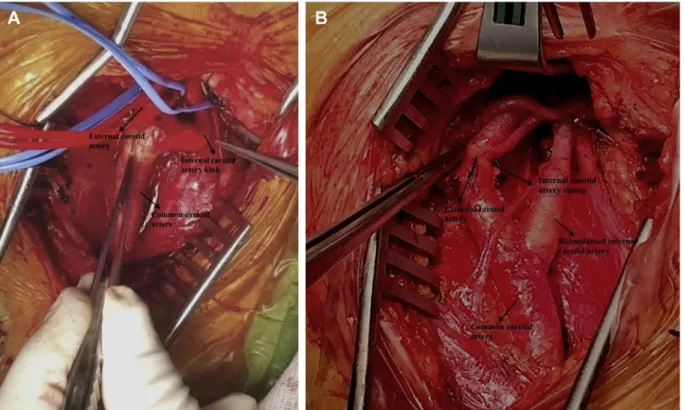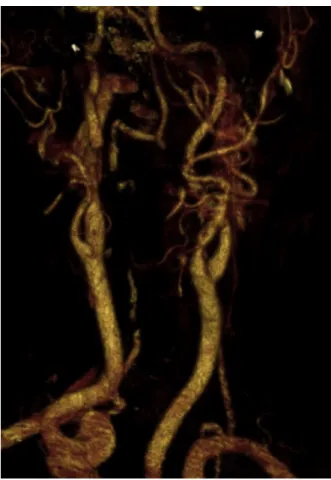A Rare and Subtle Etiology of Chronic
Oropharyngeal Pain: Isolated Internal
Carotid Artery Kinking without Stenosis
Didem Melis Oztas,1Mert Meric,2Bora Basaran,3Ibrahim Erdinc,4Eren Ozgur,5Muzaffer Umutlu,5Orcun Unal,6Metin Onur Beyaz,7Mustafa Ozer Ulukan,7Serra Sencer,5 Ufuk Alpagut,2and Murat Ugurlucan,7Istanbul and Izmir, Turkey
Carotid artery kinking is a frequent finding in duplex ultrasonography. However, isolated morpho-logical changes without significant carotid stenosis are rarely symptomatic. Neck pain is a rare symptom in patients with carotid artery kinks. The vascular etiology in patients with persistent neck pain is usually overlooked. A 58-year-old female patient with chronic neck pain presented to our clinic. Following multidisciplinary team review, the symptoms were found due to the kink-ing of the internal carotid artery. In this report, we present the clinical presentation of the patient with the kinking of the internal carotid artery without stenosis, surgical management of the pa-thology, and a brief literature review.
Morphological changes in internal carotid artery such as kinking are frequent among the general population; however, it is asymptomatic in most of the cases. Depending on asymptomatic population, carotid artery kinking is usually diagnosed inciden-tally. It has an increased incidence rate in older age group, female gender, patients with hyperlipidemia, hypertension, diabetes mellitus, and ischemic heart disease.1
Despite being a silent disorder in most of the cases, internal carotid artery kinking without signif-icant stenosis may result in hemispheric and nonhe-mispheric symptoms. There are controversial data
on whether morphological changes in internal ca-rotid artery may cause caca-rotid artery stenosis and ischemic stroke.2In cases of cerebral insufficiency, carotid artery screening is almost always required, which reveals the abnormal course of the carotid ar-tery. However, in patients with nonhemispheric symptoms such as chronic neck pain, the vascular etiology is usually overlooked.
In this case report, we present a 58-year-old fe-male patient who had chronic neck pain which could not be relieved despite various surgical inter-ventions. Multidisciplinary team review provided no other cause for the symptoms other than internal
1Cardiovascular Surgery Clinic, Bagcilar Training and Research
Hospital, Istanbul, Turkey.
2
Department of Cardiovascular Surgery, Istanbul Medical Faculty, Istanbul University, Istanbul, Turkey.
3
Department of Ear-Nose-Throat, Istanbul Medical Faculty, Istan-bul University, IstanIstan-bul, Turkey.
4Department of Cardiovascular Surgery, Bozyaka Training and
Research Hospital, Istanbul, Turkey.
5
Department of Radiology, Istanbul Medical Faculty, Istanbul Uni-versity, Istanbul, Turkey.
6Department of Cardiovascular Surgery, Yedikule Chest Diseases
and Thoracic Surgery Education and Research Hospital, Istanbul, Turkey.
7Faculty of Medicine, Department of Cardiovascular Surgery,
Istan-bul Medipol University, IstanIstan-bul, Turkey.
Correspondence to: Murat Ugurlucan, Faculty of Medicine, Depart-ment of Cardiovascular Surgery, Istanbul Medipol University, TEM Avrupa Otoyolu Goztepe Cikisi, No:1, 34214 Bagcilar, Istanbul, Turkey; E-mails: muratugurlucan@yahoo.comordidem_mls@hotmail.com Ann Vasc Surg 2020; 62: 496.e15–496.e18
https://doi.org/10.1016/j.avsg.2019.06.019 Ó 2019 Elsevier Inc. All rights reserved.
Manuscript received: May 14, 2019; manuscript accepted: June 8, 2019; published online: 23 August 2019
carotid artery kinking. Hence, the patient was considered for surgical correction.
CASE REPORT
A 58-year-old female patient was referred to our clinic with chronic pain at the oropharynx. Physical examina-tion revealed a pulsating mass and ulceraexamina-tion at the left posterolateral side of the oral cavity above the left tonsil. Manual compression over the eroded region increased the pain of the patient. Auscultation of the neck indicated an atypical bruit over the left carotid artery. The patient has previously been investigated for the pain and under-went bilateral tonsillectomy and thyroidectomy; howev-er, her symptoms persisted.
Carotid artery duplex ultrasonography showed a kinked left internal carotid artery without stenosis. Computed tomography angiography confirmed the tortu-osity of the left internal carotid artery with increased devi-ation toward the oropharynx (Fig. 1). The patient was consulted with neurology and ear-nose-throat depart-ments and no other cause for the pain symptoms was identified. She was scheduled for surgical treatment after her consent.
Operation was performed with general anesthesia. Neurologic monitoring was provided with continuous near infrared spectromicroscopy (NIRS) evaluation throughout the procedure. Following left cervical
incision, common carotid, internal and external carotid arteries were dissected and looped. There was medial kink at the superior segment of the internal carotid ar-tery (Fig. 2A). The internal carotid artery was long segment dissected free from adhesions from the adja-cent structures. The carotid arteries were clamped after systemic 100 U/kg heparin administration. The internal carotid artery was divided from the carotid bifurcation. It was retracted approximately 2.5e3 cm inferiorly (Fig. 2B) and reanastomosed to the common carotid ar-tery (Fig. 3B). The internal carotid artery stump was pri-marily sutured and clamps were removed. A significant decline in the NIRS values was not observed throughout the surgery and the patient was extubated without any neurologic deficit immediately. Postoperative course was uneventful, her symptoms disappeared, and pulsat-ing image at the left oropharynx was not observed. She was discharged from the hospital on the postoperative third day. She has been followed symptom free and postoperative sixth-month and first-year control computerized tomography angiography indicated nor-mally configured carotid arteries away from the oropharynx (Figs. 3and4,cine).
DISCUSSION
The etiology of the morphological changes in inter-nal carotid artery remains controversial. It is Fig. 1. (A) Preoperative computerized tomography
angi-ography showing left internal carotid artery kink, medial deviation, and oropharyngeal compression. (B)
Preoperative computerized tomography angiography showing left internal carotid artery kink and medial deviation.
mentioned that fibromuscular dysplasia has a possible etiological role. Another hypothesis is that kinking of internal carotid artery can be congenital, resulting from embryological causes.3Even though
the pathophysiological mechanism of the morpho-logical changes in the internal carotid artery re-mains unclear, it is known that carotid kinking has an increased incidence rate in older age group, fe-male gender, and patients with hyperlipidemia, hy-pertension, diabetes mellitus, and ischemic heart disease.1In our case, the patient was female, had a history of diabetes mellitus and hypertension, hence she was in consistency with the presumed risk factors.
There is surgical indication to repair the signifi-cantly stenotic kinking of the internal carotid artery in patients with neurologic symptoms. However, the data are controversial on treatment of the iso-lated morphological changes without carotid steno-sis. This controversy is based on whether isolated morphological changes in internal carotid artery cause cerebral insufficiency or not.2 In the ‘‘2017 Clinical Practice Guidelines of the European Society for Vascular Surgery,’’ it is stated that surgical inter-vention for asymptomatic isolated coils/kinks of the internal carotid artery is not recommended. Howev-er, symptomatic patients with isolated coils/kinks that provided no other cause for symptoms may be considered for surgical correction following multi-disciplinary team review, as mentioned in the guideline with IIb class of recommendation.4 We Fig. 2. Surgical exploration and treatment. (A) Surgical
view of the kink. (The internal carotid artery is retracted for a better quality image). (B) Resection, retraction, and
proximal reimplantation of the internal carotid artery to the common carotid artery.
Fig. 3. Postoperative sixth-month control computerized tomography angiography.
consulted our particular patient with neurology and ear-nose-throat departments due to persistent neck pain and no other cause for the pain symptoms could be identified other than isolated carotid kink-ing. Therefore, the patient was scheduled for surgi-cal treatment.
The treatment of the morphological changes in internal carotid artery may be performed with various techniques. Resection and end-to-end anas-tomosis, shortening and reimplantation of the inter-nal carotid artery to the common carotid artery, resection and shortening of the common carotid tery, common carotid artery to internal carotid ar-tery bypass grafting, and transposition of the internal carotid artery to the external carotid artery are possible surgical techniques which are consid-ered depending on the presence of a concomitant
atherosclerotic stenosis, length of the carotid artery, position and the complexity of the kinking, and the diameter and the quality of the adjacent arteries.5,6 In our case, there was no carotid artery stenosis in the patient and the symptoms were depended on the isolated carotid kinking. Hence, we decided divi-sion and proximal reimplantation of the internal ca-rotid artery to the common caca-rotid artery for surgical correction of the anatomy.
In conclusion, although carotid kinks are frequently corrected during the treatment of athero-sclerotic lesions of the carotid vessels worldwide as in our group, isolated carotid kinks without carotid stenosis are rarely symptomatic and require inter-vention. Vascular etiology should also be remarked in patients with chronic persisting neck and oropha-ryngeal pain and patients should be offered treat-ment following multidisciplinary team review.
SUPPLEMENTARY DATA
Supplementary data related to this article can be found at https://doi.org/10.1016/j.avsg.2019.06. 019.
REFERENCES
1. Martins HFG, Mayer A, Batista P, et al. Morphological changes of the internal carotid artery: prevalence and charac-teristics. A clinical and ultrasonographic study in a series of 19 804 patients over 25 years old. Eur J Neurol 2018;25:171e7. 2. Weibel J, Fields WS. Tortuosity, coiling, and kinking of the internal carotid artery. II. Relationship of morphological vari-ation to cerebrovascular insufficiency. Neurology 1965;15: 462e8.
3. Macchi C, Gulisano M, Giannelli F, et al. Kinking of the hu-man internal carotid artery: a statistical study in 100 healthy subjects by echocolor Doppler. J Cardiovasc Surg (Torino) 1997;38:629e37.
4. Naylor AR, Ricco JB, de Borst GJ, et al. Editor’s choicedMa-nagement of atherosclerotic carotid and vertebral artery dis-ease: 2017 Clinical Practice Guidelines of the European Society for Vascular Surgery (ESVS). Eur J Vasc Endovasc Surg 2018;55:3e81.
5. Alpagut U, Ugurlucan M, Kafali E, et al. Aneurysm of the kinked extracranial internal carotid artery case report and re-view of the literature. Actachir Belg 2005;105:407e9. 6. Oztas DM, Ugurlucan M, Sayin OA, et al. Surgical treatment
of localized dissection of the internal carotid artery. Ann Vasc Surg 2015;29:1018.e13e6.
Fig. 4. Postoperative first-year control computerized to-mography angiography.

